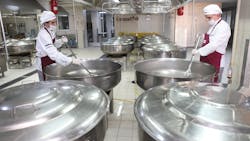Selecting the best drainage systems for food and beverage processing
Whether you are building a new facility or upgrading an existing one, it is vital to have a well-designed drainage system throughout your processing areas. In fact, the North American Meat Institute (NAMI) lists the prevention of liquid accumulation as one of the top three principles of sanitary facility design.
Poor drainage in a food and beverage facility can impede the sanitation process and greatly affect overall food safety. Meanwhile, proper drainage design speeds up cleaning and reduces health and safety risks for both workers and production.
When done incorrectly, your facility’s drainage system can contaminate ingredients and products that then must be discarded, directly impacting your bottom line. In addition, recalls caused by product contamination can damage both your company’s reputation and your product category.
What is the best type of drainage system for a food plant?
Even with robust cleaning measures in place, the wrong drainage system puts your facility at elevated risk. Therefore, it is critically important to consider the various aspects that impact drainage design during the schematic design phase and select a type of drain that best meets your facility’s needs.
Trench drains
Trench drains are a common type of drain used in food and beverage facilities. These recessed systems consist of a trough with a drain channel throughout. Channels vary in size depending on the facility’s needs. These drains work well to collect fluids. However, trench drains are often covered with a heavy grate, which can make them difficult to maintain and clean thoroughly.
Slot drains
Slot drains are pre-sloped and pre-assembled systems that are strong and durable. These drains feature a slimmer drain channel compared to trench drains, which eliminates the need for heavy grates that are difficult to clean. Their rounded design allows for easy cleaning and maintenance, making them more sanitary than trench drains. Slot drains can also be used with a clean-in-place (CIP) system, allowing your cleaning process to be automated.
Point drains
Point drains collect water from a single device and are often found at the center of a sloped floor region. They are typically installed in areas that need drainage funneled to a singular point or a defined area.
The downside is multiple devices are required to drain large floor areas. Additionally, point drains generally require more excavation and support for proper installation, which can be expensive and labor-intensive.
5 top considerations for drainage
While the type of drain is important, other considerations are also prudent when selecting drainage options for a food-safe facility.
1. Location
Consider the location of your drains and how they are spaced apart. Drains that are spaced too far apart have the potential to create standing water, resulting in microbial growth, such as listeria, salmonella, E. coli and other hazards that can be incredibly harmful — or even deadly — to humans.
It is important to have enough drains placed appropriately throughout a space to allow liquid to flow freely to the collection point. A good rule of thumb is to provide one drain per 600 square feet of floor area.
2. Materials
Material selection plays a significant role in the food safety of a facility. While drains come in a wide variety of materials, not all are suitable for food and beverage processing. It is best to specify FDA- or USDA-recommended food-grade stainless steel.
Drain body materials need to be cleanable, rust-resistant and capable of withstanding high-temperature and corrosive chemical cleaning solutions. The drainage piping will require similar characteristics.
3. Avoiding grates
While most trench drains rely on grates, these are hard to clean and can even be dangerous for workers. Grates need to be cleaned regularly. With constant exposure to fluids and natural acids from foods, as well as the heavy weight of machinery, they often weaken and break down over time. This can lead to injuries and add to drain maintenance costs.
4. Ease of cleaning
While FDA- or USDA-approved food-grade stainless steel is bacteria-resistant, it is also important to consider the ease of cleaning. Removable grates, lids, drain baskets and P-Trap assemblies must be considered when selecting drainage devices.
5. The pitch and type of flooring
The floor surface is equally important as the type of drain installed. For any drainage system to work, floors must have a specific pitch (or slope) to allow water to flow and prevent standing water. The floor surface should meet or be flush with the drain device, so water will not dam up where the two surfaces meet.
Selecting the proper type of drainage system is an essential component of designing a food-safe facility. Improper drainage can be hazardous for employees and harbor pathogens and bacteria that lead to food contamination, recalls and production pauses, all of which impact a facility’s bottom line and reputation.
As a design-build firm, Stellar can recommend drainage systems best suited for your facility as early as the pre-planning stage of the design process. Our team can quickly adapt to provide optimal solutions — all while minimizing cost, delays and other potential issues — to help create a drainage system uniquely suited to your facility’s needs.
About Stellar
Stellar is a fully integrated firm focused on planning, design, pre-construction, construction, refrigeration, mechanical & utility, building envelope, and total operations & maintenance services worldwide. Visit the company's blog at www.stellarfoodforthought.netor learn about its projects at stellar.net.
About the Author
Joseph Bove
Vice President of Design Engineering, Stellar
Joe has more than 37 years of experience in the design, engineering and construction of food processing plants. Joe develops architectural and engineering standards to ensure compliance with client procedures, government codes and standards. Joe has managed projects for Burris Refrigerated Logistics, General Mills/Pillsbury Bakeries, Kraft Foods, Nestlé, Sysco and many other brand-name food companies.
